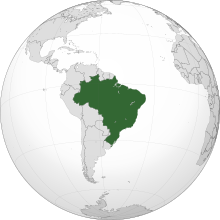Brazilian portuguese
| Brazilian Portuguese | |
|---|---|
| Português do Brasil português brasileiro |
|
|
Native speakers
|
204 million (2015) |
|
Indo-European
|
|
| Official status | |
|
Official language in
|
|
| Language codes | |
| ISO 639-3 | – |
| Glottolog | braz1246 |
| IETF | pt-BR |

|
|
Brazilian Portuguese (português do Brasil [poʁtuˈɡez du bɾaˈziw] or português brasileiro [poʁtuˈɡez bɾaziˈlejɾu]) is a set of dialects of the Portuguese language used mostly in Brazil. It is spoken by virtually all of the 200 million inhabitants of Brazil and spoken widely across the Brazilian diaspora, today consisting of about two million Brazilians who have emigrated to other countries.
This variety of the Portuguese language differs, particularly in phonology and prosody, from varieties and dialects spoken in most Portuguese-speaking majority countries, including native Portugal and African countries – the dialects of which, partly because of the more recent end of Portuguese colonialism in these regions, tend to have a closer connection to contemporary European Portuguese. Despite this, Brazilian and European Portuguese vary little in formal writing (in many ways analogous to the differences encountered between American and British English).
In 1990, the Community of Portuguese Language Countries (CPLP), which included representatives from all countries with Portuguese as the official language, reached an agreement on the reform of the Portuguese orthography to unify the two standards then in use by Brazil on one side and the remaining Lusophone countries on the other. This spelling reform went into effect in Brazil on 1 January 2009. In Portugal, the reform was signed into law by the President on 21 July 2008 allowing for a 6-year adaptation period, during which both orthographies co-existed. All of the CPLP countries have signed the reform. In Brazil, this reform will be in force as of January 2016. Portugal and other Portuguese-speaking countries have since begun using the new orthography.
...
Wikipedia
